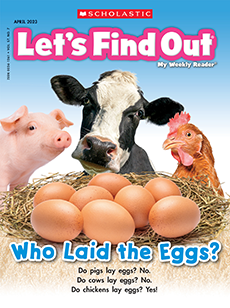Academic Standards
Learning Objective:
Children will understand how animals adapt to seasonal changes.
Science Focus:
seasons, animal behavior
Page 4 skill:
read a chart
Vocabulary:
capa, hibernar
CCSS (and states that have similar standards):
RI.K.1 key details, RI.K.4 vocabulary, RL.K.1 key details (literature), SL.K.1 collaborative discussions, SL.K.2 confirm understanding by answering questions
Watch the video
Watch the video
Build background knowledge about the autumn changes by watching “¡Llegó el otoño!” When you’re done watching, ask the following question: ¿Qué pasa en otoño donde viven?
Preview new vocabulary words
Preview new vocabulary words
Project the online vocabulary slideshow and introduce this issue’s featured words.
Set a purpose for reading
Set a purpose for reading
- Have students do a picture walk through the issue. Then read and discuss the cover. Ask students to predict what the squirrel’s new job is.
- Then, before turning to page 2, say, “En este artículo, aprenderemos sobre las cosas que los animales hacen en otoño para estar listos para el invierno. Mientras leemos el artículo, piesen cómo los animales se preparan para el invierno.”
- After you read each box, check comprehension by discussing what each animal does in autumn. (“¿Qué hacen las ardillas para prepararse para el invierno?”) Then ask children “¿Por qué esto les sirve para estar listas para el invierno?”.
- After reading the sidebar, ask children to share what autumn changes they see in your area.
- Complete the page 4 activity as a group or individually.
- When you’re done reading, do the ¡BAILA BAILA!
- Demuestra lo que sabes (skill: comprehension)
- ¡Encuentra los frutos secos! (skill: visual discrimination)
Deepen students’ learning with any of these supplemental activities:
Play the online game: Encuentra el otoño
(skill: apply knowledge)
Complete a hands-on activity: Observa la ardilla
Kids will go outdoors to observe squirrels and record what they see. (skill: observation and recording)
Read a paired text:
In El otoño ya está aquí by Albert Asensio, a squirrel knows it’s autumn by observing how other animals behave.
